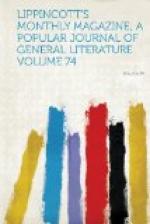H. JAMES, JR.
LITTLE LIZAY.
Alston was a Virginia slave—a tall, well-built half-breed, in whom the white blood dominated the black. When about thirty-seven years of age he was sold to a Mississippi plantation, in the north-western part of the State and on the river. The farm was managed by an overseer, the master—Horton by name—being a practising physician in Memphis, Tenn. Alston had been on the plantation a few weeks when, toward the last of September, the cotton-picking season opened. The year had been, for the river-plantations, exceptionally favorable for cotton-growing. On the Horton place especially “the stand” had been pronounced perfect, there being scarcely a gap, scarcely a stalk missing from the mile-long rows of the broad fields. Then, the rainfall had not been so profuse as to develop foliage at the bolls’ expense, as was too frequently the case on the river. Yet it had been plenteous enough to keep off the “rust,” from which the dryer upland plantations were now suffering. Neither the “boll-worm” nor the dreaded “army-worm” had molested the river-fields; so the tall pyramidal plants were thickly set with “squares” and green egg-shaped bolls, smooth and shining as with varnish. On a single stalk might be seen all stages of development—from the ripe, brown boll, parted starlike, with the long white fleece depending, to the bean-sized embryo from which the crimson flower had but just fallen. Indeed, among the wide-open bolls there was an occasional flower, cream-hued or crimson according to its age, for the cotton-bloom at opening resembles in color the magnolia-blossom, but this changes quickly to a deep crimson.




